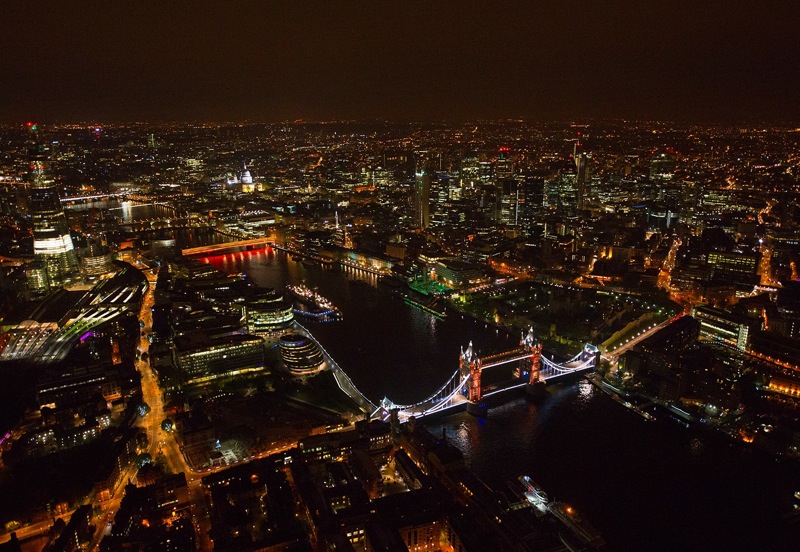
Welcome to visit Zhongshan Diamond Lighting Factory Official Website.

Tel : +86-760-22328828

E-mail : diamond@modernlamp.com
GE caught paying for Olympic gold
Date: 2012-06-30
By Mark Halper | June 25,2012,4:56 AM PDT

This story is not the scandal that the headline might suggest.
Rather, it’s a little ditty about modern, public, low energy, architectural lighting - and how to pay for it.
Anyone who has wandered near London’s iconic Tower Bridge at night recently might have noticed it lit up (notice I didn’t write
“glow”;more on that below) in gold, silver, blue, red or some collection of colors, over the River Thames.
That’s because London has replaced the 118-year-old bridge’s static bulbs with LED lighting. While LEDs are well known for the their energy saving qualities, they also lend
themselves to digital control because they themselves are digital. LEDs - light emitting diodes - are rudimentary semiconductors,
and operators can remotely change their brightness and color scheme.

GE, bringing good ads to light: The GE and EDF logos adorn London's Tower Bridge.
London and Mayor Boris Johnson ceremoniously switched on the lights in late May, showing off a spectrum of colors - have
a look at some of the photos. As the London Olympics approach, expect to see a lot of gold and silver, as the Mayor told us last
November when he first announced the project. The lights gleamed white for the Queen’s Diamond Jubilee earlier this month.

The lighting scheme entials “1,800 special energy efficient LED lights” and “2,000 meters of energy efficient LED linear lights,”
according to a mayoral press release (2,000 meters is 6,561 feet - or over a mile - on a bridge that’s 801 feet long, has two
213-foot high gothic turrets, and a 143-foot walkway between the towers).
So how much is this costing the taxpayer?
Nothing, according to the release, which says that General Electric and French utility EDF are footing the bill.
The scheme is expected to last for 25 years and, as LEDs do, to save a lot of energy, although not as much as you might guess.
The press release says the lights will cut energy consumption by 40 percent, which is a lot less than the “80 percent” claims that
LED vendors normally make.

I asked the Mayor Johnson’s office a month ago to explain the discrepancy. They promised an answer, but I haven’t heard
back yet. Maybe “40 percent” is a new honesty. Maybe Tower Bridge was already lit by moderately energy efficient lighting.
Or maybe it reflects London’s intentions to use the lights more than it had used its one-color bulbs. For instance, it’s planning a dazzling light show with the LEDs this Wednesday, to celebrate the Olympic rings that
London is lowering onto the bridge. The lights will also show off in special displays during the Olympics.

Now,about that“glow.”I like LED lighting for all sorts of all sorts of reasons,such as the energy savings and control that I've
described above.but whenever I see them on public structures, I'm struck by a light quality that's different from what I'm used
to.My eye does not perceive a"glow"per se,and it always detects a hint of a "control panel"look.You could name the palette
choices things like “control panel blue”or“digital display red.”
We’ve all been conditioned by incandescent bulbs, which burn a filament. As someone wrote recently, fire has provided our
light source pretty much since the time man discovered the hot stuff. I’m getting to like outdoor LED lighting. It presents more
colorful options.But let’s face it, it is somewhat colder than a glow. How do you see it?
Photos, top to bottom: Simon Kennedy, Andy Matthews, Andy Matthews, Jason Hawkes, Jason Hawkes. All via GE and
Reformer Films.

This story is not the scandal that the headline might suggest.
Rather, it’s a little ditty about modern, public, low energy, architectural lighting - and how to pay for it.
Anyone who has wandered near London’s iconic Tower Bridge at night recently might have noticed it lit up (notice I didn’t write
“glow”;more on that below) in gold, silver, blue, red or some collection of colors, over the River Thames.
That’s because London has replaced the 118-year-old bridge’s static bulbs with LED lighting. While LEDs are well known for the their energy saving qualities, they also lend
themselves to digital control because they themselves are digital. LEDs - light emitting diodes - are rudimentary semiconductors,
and operators can remotely change their brightness and color scheme.

GE, bringing good ads to light: The GE and EDF logos adorn London's Tower Bridge.
London and Mayor Boris Johnson ceremoniously switched on the lights in late May, showing off a spectrum of colors - have
a look at some of the photos. As the London Olympics approach, expect to see a lot of gold and silver, as the Mayor told us last
November when he first announced the project. The lights gleamed white for the Queen’s Diamond Jubilee earlier this month.

The lighting scheme entials “1,800 special energy efficient LED lights” and “2,000 meters of energy efficient LED linear lights,”
according to a mayoral press release (2,000 meters is 6,561 feet - or over a mile - on a bridge that’s 801 feet long, has two
213-foot high gothic turrets, and a 143-foot walkway between the towers).
So how much is this costing the taxpayer?
Nothing, according to the release, which says that General Electric and French utility EDF are footing the bill.
The scheme is expected to last for 25 years and, as LEDs do, to save a lot of energy, although not as much as you might guess.
The press release says the lights will cut energy consumption by 40 percent, which is a lot less than the “80 percent” claims that
LED vendors normally make.

I asked the Mayor Johnson’s office a month ago to explain the discrepancy. They promised an answer, but I haven’t heard
back yet. Maybe “40 percent” is a new honesty. Maybe Tower Bridge was already lit by moderately energy efficient lighting.
Or maybe it reflects London’s intentions to use the lights more than it had used its one-color bulbs. For instance, it’s planning a dazzling light show with the LEDs this Wednesday, to celebrate the Olympic rings that
London is lowering onto the bridge. The lights will also show off in special displays during the Olympics.

Now,about that“glow.”I like LED lighting for all sorts of all sorts of reasons,such as the energy savings and control that I've
described above.but whenever I see them on public structures, I'm struck by a light quality that's different from what I'm used
to.My eye does not perceive a"glow"per se,and it always detects a hint of a "control panel"look.You could name the palette
choices things like “control panel blue”or“digital display red.”
We’ve all been conditioned by incandescent bulbs, which burn a filament. As someone wrote recently, fire has provided our
light source pretty much since the time man discovered the hot stuff. I’m getting to like outdoor LED lighting. It presents more
colorful options.But let’s face it, it is somewhat colder than a glow. How do you see it?
Photos, top to bottom: Simon Kennedy, Andy Matthews, Andy Matthews, Jason Hawkes, Jason Hawkes. All via GE and
Reformer Films.
